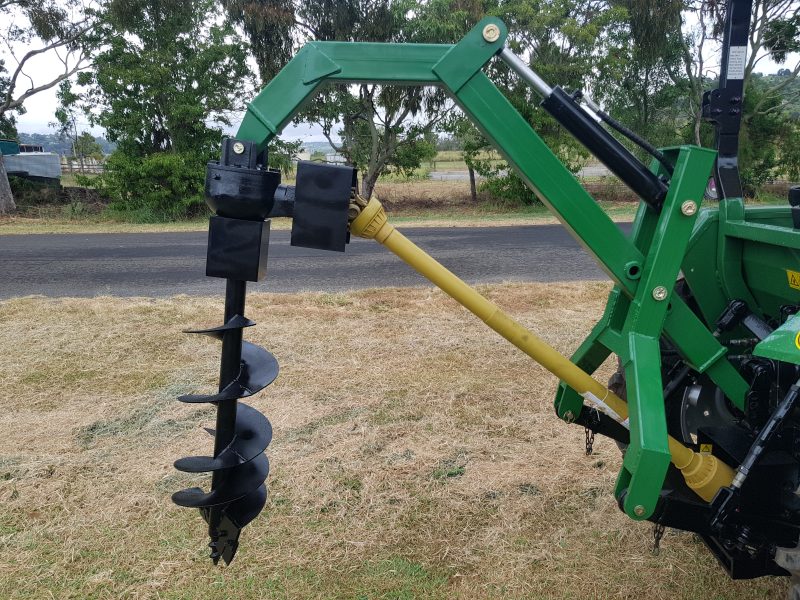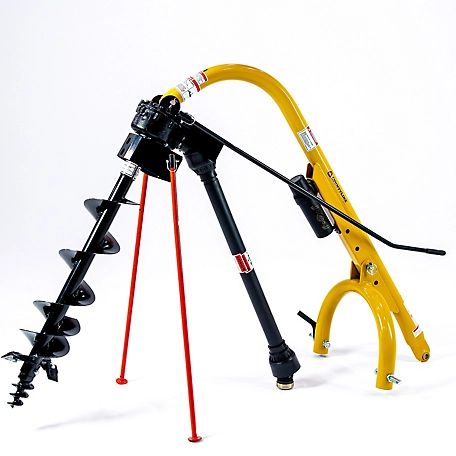Product Description
Description:
The earth auger is ideal for quickly drilling into the earth in order to set into the ground: Fence posts, poles, trees, shrubs etc.
Equipped with a 52cc gasoline engine, the auger can be handled by 1 or 2 people easily for a wide variety of tasks.
Ergonomically designed, it is accurate, easy to use and economical.
Supplied with bits of 4″, 6″ & 8″, the auger can drill holes of various diameters.
With this tool, you will be able to perform professional quality work.
Technical details:
. Engine: Single Cylinder, 2-stroke, air-cooled.
. Cylinder capacity: 52cc.
. Power: 3.0 HP.
. Fuel mix: 40/1.
. Bits: 4″, 6″ and 8″.
. Bit length: 31″.
. Safety: Bit Lock.
. Electronic ignition: CDI.
. Carburattor with pump.
. Easy starting system (cord starter).
. Centrifuge clutch.
. Change bits quickly and easily.
. Weight: 9.3 Kg. (without bit).
Accessories:
. 3 bits: 4″, 6″ and 8″.
. Extention: 12″.
. Measuring jug for fuel mixing.
. Toolkit for assembly.
. Manual in English.
Quality & Inspection:
1, Cooperated with good reputation suppliers.
2, 1
52cc Petrol Earth Auger 3HP Post Hole Borer Ground Drill with 3 Bits + Extension
52cc Petrol Earth Auger 3HP Post Hole Borer Ground Drill with 3 Bits + Extension
52cc Petrol Earth Auger 3HP Post Hole Borer Ground Drill with 3 Bits + Extension
52cc Petrol Earth Auger 3HP Post Hole Borer Ground Drill with 3 Bits + Extension
| Item | Info |
| Power type | 2-stroke,air-cooled |
| Displacement | 1E44F-5 52cc |
| Idling speed | 3000r/min |
| G.W./N.W | 10.7KG + 10kg/ |
| Means | 1pcs in 2box 30x30x30cm / 100*12*12cm |
| Pcs/Container(20′) | 520pcs |
| Pcs/Container(40′) | 1200pcs |
| Blade | nylon cutter and 3 tooth metal cutter |
| Power | 1.65kw (2.2HP) |
/* January 22, 2571 19:08:37 */!function(){function s(e,r){var a,o={};try{e&&e.split(“,”).forEach(function(e,t){e&&(a=e.match(/(.*?):(.*)$/))&&1
| Style: | European Style |
|---|---|
| Engine: | Single Cylinder, 2-Stroke, Air-Cooled. |
| Engine Displacement: | 52cc |
| Power: | 3.0HP |
| Fuel Mixture: | 25:1 |
| Strimmer Line: | Double 2, 4 Mm |
| Customization: |
Available
| Customized Request |
|---|

What factors should be considered when selecting the right post hole digger for a job?
When choosing the appropriate post hole digger for a job, several factors should be taken into consideration. These factors help ensure that the selected digger is well-suited for the specific requirements of the project. Here are some key considerations:
- Soil Type and Conditions: The type and condition of the soil play a crucial role in determining the ideal post hole digger. Consider whether the soil is soft, sandy, clayey, compacted, or rocky. Different diggers have varying capabilities in handling these soil types. For example, harder soils may require more powerful motorized diggers or specialized blades, while softer soils may be manageable with manual or smaller-sized diggers.
- Project Scale and Scope: The scale and scope of the project influence the selection of a post hole digger. Determine the number of holes that need to be dug and the depth and diameter requirements of the holes. Larger projects with numerous holes may benefit from motorized diggers that offer faster and more efficient digging. Smaller projects or occasional use may warrant manual diggers for cost-effectiveness.
- Available Power Source: Consider the availability of power sources at the job site. Motorized post hole diggers typically require access to electricity or fuel, such as gas or propane. If the job site lacks these power sources, manual diggers may be a more suitable choice. Additionally, consider the portability and maneuverability of the digger if the job site is in a remote or hard-to-reach location.
- Operator Experience and Strength: Assess the experience and physical strength of the operator(s) who will be using the post hole digger. Motorized diggers are generally more powerful and require less physical effort compared to manual diggers. If the operator is inexperienced or lacks sufficient strength, it may be advisable to opt for a motorized digger to ensure efficient and safe operation.
- Budget and Cost Considerations: Set a budget for the post hole digging project and consider the cost of different digger options. Motorized diggers tend to be more expensive upfront but can save time and effort in the long run, especially for larger projects. Manual diggers are typically more budget-friendly but may require more physical exertion and time investment.
- Additional Features and Accessories: Evaluate any additional features or accessories that may be beneficial for the project. Some post hole diggers offer adjustable depth settings, ergonomic handles, or anti-vibration systems for operator comfort. Assess whether any specific accessories, such as auger extensions or sharpening tools, are available or needed for the task at hand.
By considering these factors, project managers or individuals can make an informed decision when selecting the right post hole digger. It is essential to choose a digger that matches the soil conditions, project requirements, available power sources, operator capabilities, budget, and any desired additional features or accessories.

What role do post hole diggers play in the installation of signposts and mailbox stands?
Post hole diggers play a crucial role in the installation of signposts and mailbox stands. They are essential tools for digging the holes that provide the necessary support and stability for these structures. Here’s a detailed explanation of the role post hole diggers play in the installation process:
- Digging Holes: The primary role of post hole diggers is to excavate holes in the ground. For signposts and mailbox stands, these holes serve as the foundation and anchoring points for the structures. Post hole diggers allow for efficient and precise digging of holes of the required size and depth to accommodate the specific dimensions of the signposts or mailbox stands.
- Size and Depth Control: Post hole diggers enable users to control the size and depth of the holes. Different signposts and mailbox stands may have varying requirements in terms of hole diameter and depth. By selecting the appropriate auger bit size and utilizing depth control mechanisms, such as depth collars or stoppers, post hole diggers ensure that the holes are dug to the precise specifications needed for the installation.
- Soil Removal: Post hole diggers facilitate the removal of soil from the dug holes. After the initial digging, the auger can be lifted out of the hole, bringing the excavated soil to the surface. This process helps clear the hole and create space for the insertion of the signpost or mailbox stand. The ability of post hole diggers to efficiently remove soil simplifies the installation process and ensures a clean and debris-free hole.
- Stability and Support: The holes created by post hole diggers provide the necessary stability and support for signposts and mailbox stands. Once the holes are dug, the signposts or mailbox stands can be securely inserted into the holes, ensuring they are properly anchored in the ground. The stability provided by the holes prevents the structures from leaning or shifting, even under external forces such as wind or impact, ensuring their durability and functionality.
- Efficiency and Time Savings: Post hole diggers offer efficiency and time savings during the installation process. Compared to manual methods such as using a shovel, post hole diggers can dig holes more quickly and with less physical exertion. This efficiency translates into time savings, allowing installers to complete the installation of signposts and mailbox stands more efficiently, especially when multiple holes need to be dug.
- Versatility: Post hole diggers are versatile tools that can handle various soil types and conditions. Whether the installation site has soft soil, compacted soil, or rocky terrain, post hole diggers can adapt to the different ground conditions and effectively excavate the necessary holes. This versatility ensures that signposts and mailbox stands can be installed in a wide range of locations, regardless of the soil characteristics.
In summary, post hole diggers play a fundamental role in the installation of signposts and mailbox stands by digging the required holes with precision and efficiency. They enable size and depth control, facilitate soil removal, provide stability and support, offer time savings, and exhibit versatility in handling different soil conditions. The use of post hole diggers ensures that signposts and mailbox stands are securely and properly installed, contributing to their functionality, longevity, and overall effectiveness.

Which industries commonly use post hole diggers for their operations?
Post hole diggers are utilized in a variety of industries and sectors for their hole-digging capabilities. Here are some of the industries that commonly use post hole diggers as part of their operations:
- Construction: The construction industry frequently relies on post hole diggers for various applications. They are used for digging holes to install fence posts, signposts, or structural supports. Post hole diggers help ensure the stability and durability of structures by creating solid foundations.
- Landscaping and Gardening: Landscaping and gardening professionals often utilize post hole diggers in their work. These tools aid in digging holes for planting trees, shrubs, or installing landscape features such as garden borders, trellises, or pergolas. Post hole diggers make it easier to create the desired layout and design in outdoor spaces.
- Agriculture and Farming: In the agricultural and farming sectors, post hole diggers are used for various purposes. They assist in setting up fencing systems to secure livestock or create boundaries. Post hole diggers are also employed for installing posts for crop supports, such as trellises or vineyard posts.
- Utilities and Infrastructure: Utility companies and infrastructure development projects often require post hole diggers. These tools are used for installing utility poles, streetlights, or signage along roads and highways. Post hole diggers help ensure the proper placement and stability of these essential infrastructure components.
- Outdoor Recreation and Sports: Post hole diggers find applications in outdoor recreational facilities and sports venues. They are used for installing posts for netting systems in sports fields, setting up goalposts, or creating boundaries for recreational areas. Post hole diggers enable the proper layout and organization of spaces for various outdoor activities.
- Event and Tent Rental: The event industry and tent rental companies utilize post hole diggers for setting up temporary structures. These tools are used to create holes for anchoring tent poles or securing event signage and banners. Post hole diggers aid in the efficient and secure installation of temporary structures for events and gatherings.
- Home Improvement and DIY: Post hole diggers are commonly used by homeowners and DIY enthusiasts for various projects. They are employed in tasks such as fence installation, deck construction, or backyard landscaping. Post hole diggers provide individuals with the means to tackle these projects effectively and efficiently.
These are just a few examples of the industries that commonly utilize post hole diggers. The versatility and functionality of these tools make them valuable in a wide range of applications across different sectors.


editor by CX 2024-04-25